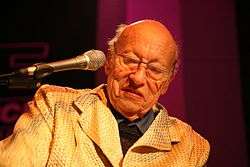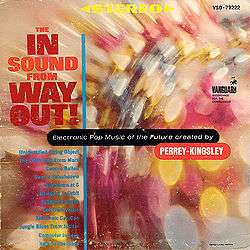Perrey and Kingsley

The musical duo Perrey and Kingsley (Jean-Jacques Perrey 1929-2016[1] and Gershon Kingsley, b. 1922) are pioneers in the field of electronic music. Before their collaboration, starting in 1965, electronic music was considered to be purely avant-garde. They were among the first to create electronic music for the general public.
Musical beginnings (1938–1955)
Kingsley was born in Germany. As his father was Jewish, his family fled the Deutsches Reich in 1938 to settle in Palestine-Land of Israel where the 15-year-old, self-taught musician began his career in music. After World War II, Kingsley emigrated to America where he became a pit conductor for Broadway musical shows after graduating from the Los Angeles Conservatory of Music.
Perrey was a French accordion player and medical student who abandoned his studies after meeting Georges Jenny in Paris in 1952. Jenny was the inventor of the Ondioline, a vacuum tube-powered keyboard instrument that was a forerunner of today's synthesizers and was capable of creating an amazing variety of sounds. Its keyboard had a unique feature — the keyboard was suspended on special springs that were capable of introducing a natural vibrato if the player moved the keyboard from side to side with the playing hand. The result was a beautiful, almost human-like vibrato that lent the Ondioline a wide range of expression. The keyboard was also pressure-sensitive, and the instrument had a knee volume lever as well. Jenny hired Perrey as a salesman and demonstrator of the new instrument. As a result, he came to the attention of French singer Édith Piaf, who sponsored him to record a demo tape that later facilitated him access to work and live in the United States between 1960 and 1970.
Early period (1955–1967)
Perrey and Kingsley came together during Kingsley's stint as a staff arranger at Vanguard Records, an independent label in New York City that specialized not in avant-garde music, but in folk music. At that time, Perrey was experimenting with tape loops, which he had been introduced to by the French avant-garde musician Pierre Schaeffer. Each loop was a laboriously hand-spliced assemblage of filtered sounds, pitch-manipulated sounds and sometimes even animal calls. The end result of their first collaborative effort in 1966 combined Perrey's tape loops, and his inventive melodies with Kingsley's complementary arrangements and instrumentation. The resulting album was filled with tunes that sounded like music from an animated cartoon gone berserk. Their first LP was titled The In Sound From Way Out! and was released on Vanguard Records that same year. Since this was decades before the advent of widespread digital technology, each tune took weeks of painstaking editing and splicing to produce.
The twelve rather whimsical tracks bore names like "Unidentified Flying Object" and "The Little Man From Mars" in an attempt to make electronic music more accessible to the general public. In fact, "Unidentified Flying Object" and another of the album's cuts, "Electronic Can-Can" eventually became theme music for "Wonderama," a Metromedia Television children's program of the early 1970s. Though most of the melodies were original, two borrowed from the classics. "Swan's Splashdown" was based on Pyotr Tchaikovsky's "Dance of the Little Swans" while "Countdown At 6" borrowed from Amilcare Ponchielli's "Dance of the Hours," much as Allan Sherman did in 1963 with his hit recording, "Hello Muddah, Hello Fadduh." The final cut on the album, "Visa To The Stars" is co-credited to "Andy Badale," who would go on to fame as Angelo Badalamenti, arranger of the music in many of David Lynch's movies. In contrast to the rest of the album, "Visa To The Stars" is a more serious gesture and lacks the unusual sound effects of the other eleven cuts. It is highly reminiscent of the style of Joe Meek and his hit, "Telstar" by The Tornados. Perrey's Ondioline carries the melody throughout. This is also comparable to Kai Winding's 1963 recording of "More", which also carries the melody on the Ondioline.
Commercial period (1967–1980)

Their second and final collaborative effort came in 1967 with the release of Kaleidoscopic Vibrations: Electronic Pop Music From Way Out, which was re-released in 1971 under the title: Kaleidoscopic Vibrations: Spotlight on the Moog. This was a similar-sounding effort, but instead of all original compositions, the album was mostly versions of popular songs of the day. In this album, Perrey's tape loops and effects were added in post-production after Kingsley's orchestrations were recorded, a technique now commonly used by electronic artists to this day. The album was one of the first to use the new Moog modular synthesizer, a massive, complicated electronic instrument resembling an old-style telephone switchboard. The album also bore two notable singles. In fact, the Moog album was released a year and a half before the release of Wendy Carlos' ground-breaking Switched-On Bach. "The Savers" would go on to fame in 1968 as the Clio Award-winning music for a television ad for No-Cal diet drinks, and in 1972 as the theme to the American television game show "The Joker's Wild".
About the time "The Savers" was being used on television, engineers with the Walt Disney Company were at work on a new parade at Disneyland Park, the "Main Street Electrical Parade." The idea was to cover floats with thousands of electronically controlled colored lights and to set the show to music. Paul Beaver and then later Disney musician Don Dorsey helped rework a Perrey-Kingsley composition called "Baroque Hoedown," an upbeat, almost sparkling number best described as "harpsichord gone country." It would become the underlying theme song of the parade for the next three decades at Disneyland, Magic Kingdom, Tokyo Disneyland, Disneyland Paris, Disney California Adventure Park, with newer arrangements still heard in updated versions of the Electrical Parade at the Magic Kingdom and Tokyo Disneyland. The Don Dorsey arrangement also appeared in Disneyland's Remember... Dreams Come True fireworks show from 2005 to 2014. Yet another arrangement serves as one of two theme songs to Disney's Paint the Night Parade, which premiered at Hong Kong Disneyland in 2014, and will premiere at Disneyland on or around May 22, 2015.
Several segments of Sesame Street produced in the 1970s also made use of music from The In Sound from Way Out, as did other television programs, such as "The Red Skelton Show." A skit from the October 23, 1976 airing of Saturday Night Live titled "Jeopardy! 1999" used "Unidentified Flying Object" as the opening and closing themes.
Legacy
Though Perrey and Kingsley never enjoyed tremendous commercial success, their music inspired a generation of musicians and was used (and still is used) extensively in advertising. Moog Indigo, a Jean-Jacques Perrey solo album from 1970 featured a cut called "E.V.A." (also co-written by "Andy Badale," aka: Angelo Badalamenti). This slow, funky track is one of the most sampled in hip hop and rap music history. A track on Siriusmo's 2010 release "The Plasterer Of Love", entitled "Blaue Sonne" features a sample of "Lovers Concerto", which features on "The In Sound from Way Out!" In the U.K., pioneered by Kenny Everett, DJs extensively used their tracks as continuity music or took clips for use as jingle backing from the late '60s and early '70s. In the U.S., it is currently being used in a TV ad for Zelnorm, a prescription medication for female irritable bowel syndrome. The same album produced "The Elephant Never Forgets" which is used as the theme of the Televisa sitcom, "El Chavo del Ocho" Even the Beastie Boys (who asked permission from Perrey and Kingsley) used both the title and cover art of P & K's first album for their own The In Sound From Way Out! album in 1996, while Smash Mouth (who didn't ask for permission) borrowed the opening riff from "Swan's Splashdown" for their 1997 hit, "Walkin' On the Sun". Gershon Kingsley's biggest contribution to mainstream pop music came in the early 1970s as the composer of "Popcorn," the single biggest hit of the German phantom-band "Hot Butter", led by American Stan Free.
Their work for Vanguard is available on a three-CD set called The Out Sound From Way In! The Complete Vanguard Recordings. The bonus CD features two remixes of "E.V.A." by Fatboy Slim, remixes of "Winchester Cathedral" and "Lover's Concerto" from Kaleidoscopic Vibrations as well as "Electronic Can-Can" and "Unidentified Flying Object," each by techno artists Eurotrash.
Perrey released four new CDs in the 2000s: Eclektronics - recorded in 1997 with musician David Chazam (Basta, 2000), and Circus of Life - recorded in 1999, with musician Gilbert Sigrist (PHMP, 2000). Perrey released The Happy Electropop Music Machine (2006), and Destination Space (2008), with musician and arranger Dana Countryman.
Perrey spent his last years in France, and was in high demand for lectures and concerts all over the world. In August 2006, Perrey gave a concert tour with Dana Countryman, of Seattle, San Francisco and Hollywood, to support the release of "The Happy Electropop Music Machine" CD. Perrey performed in Russia, in April 2007 with David Chazam, and Perrey and Countryman did a concert in Norway in September 2007. In 2008, Perrey and Chazam performed in Bucharest, Romania, and in 2008, Perrey and Countryman gave concerts in Newcastle, England, New York City and Montreal, Canada to support the release of their "Destination Space" CD, also on Oglio Records.
Perrey died at the age of 87 on November 4, 2016 from complications of lung cancer.[2]
Gershon Kingsley lives in New York City, and in 2007 was a featured performer, and received the "Lifetime Achievement Award" at Moogfest, an annual celebration of Dr. Robert Moog and his synthesizers.
Discography
- 1966: The in Sound from Way Out!
- 1967: Kaleidoscopic Vibrations: Electronic Pop Music From Way Out
- 1971: Kaleidoscopic Vibrations: Spotlight on the Moog (A re-release of the 1967 LP with a different title and cover art)
Compilations
- 1975: Incredible Synthesizer
- 1991: The Essential Perrey & Kingsley
- 2001: The Out Sound from Way In! The Complete Vanguard Recordings
- 2007: Vanguard Visionaries: Perrey & Kingsley
References
- ↑ Unterberger, Richie (2008). Jean-Jacques Perrey, AllMusicGuide.com
- ↑ Co-composer of Disney's Electrical Parade music dies. Retrieved on November 5, 2016.
External links
- Official Jean Jacques Perrey website, with interviews, photos, videos and more| UPDATE Now includes Dana Countryman's website
- Official Gershon Kingsley website with photos and audio clips
- Gershon Kingsley at allmusic.com
- Vanguard Records website
- VH1 information page
- Perrey site with long biography
- Transcript of the 1979 Saturday Night Live "Jeopardy! 1999" skit
